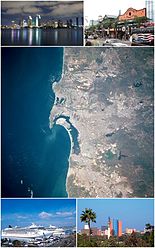Playas de Rosarito Municipality
Playas de Rosarito Municipality | ||
|---|---|---|
| Municipio de Playas de Rosarito | ||
|
INEGI code 005 | | |
| Website | (in Spanish) Ayuntamiento de Playas de Rosarito | |
| Source: Enciclopedia de los Municipios de México | ||
Playas de Rosarito Municipality (
History
At the end of the 18th century, Spanish Dominican missionaries and friars gave the name of El Rosario to an indigenous settlement in the area. The town was part of the mission of San Miguel Arcangel de la Frontera, located a few miles to the south. The mission was founded on March 28, 1787 by the Dominican friar Luis Sales on the banks of the San Juan Bautista stream.
Over time, the name of El Rosario became Rosarito. After the Mexican–American War and the Treaty of Guadalupe Hidalgo, the new Mexican border lay no more than 30 km (18.5 miles) from Rosarito. This brought the development of the Rancho de la Tia Juana, which eventually grew into the city of Tijuana, the region's development hub.
Playas de Rosarito means "beaches of Rosarito".
Boroughs
Demographics
| Year | Pop. | ±% |
|---|---|---|
| 2010 | 90,668 | — |
| 2015 | 96,734 | +6.7% |
| 2020 | 126,890 | +31.2% |
| [2][3][4][5] | ||
As of 2020, the municipality had a total population of 126,890.[1]
As of 2010, the city of Playas de Rosarito had a population of 65,278.[6] Other than the city of Playas de Rosarito, the municipality had 358 localities, the largest of which (with 2010 populations in parentheses) were: Ampliación Ejido Plan Libertador (5,906), Primo Tapia (4,921), classified as urban, and Ciudad Morelos (2,040), Colinas del Sol (1,361), and Santa Anita (1,284), classified as rural.[6]
Other localities[6]
- El Descanso (pop. 567)
- Puerto Nuevo (pop. 135)
- Santa Anita (pop. 1,284)
References
- (in Spanish) Link to tables of population data from the 2005 Census, INEGI: Instituto Nacional de Estadística, Geografía e Informática.
- (in Spanish) Playas de Rosarito, Enciclopedia de los Municipios de México, Instituto Nacional Para el Federalismo y el Desarrollo Municipal, SEGOB. Accessed on line November 15, 2007.
- ^ a b c "México en cifras". January 2016.
- ^ "Localidades y su población por municipio según tamaño de localidad" (PDF) (in Spanish). INEGI. Archived from the original (PDF) on August 31, 2018. Retrieved July 15, 2017.
- INEGI (National Institute of Statistics and Geography). Archivedfrom the original on July 2, 2017. Retrieved July 15, 2017.
- ^ "Tabulados de la Encuesta Intercensal 2015" (xls) (in Spanish). INEGI. Archived from the original on December 31, 2017. Retrieved July 15, 2017.
- INEGI. 2020. pp. 1–4. Archivedfrom the original on January 28, 2021. Retrieved January 27, 2021.
- ^ Secretaría de Desarrollo Social(SEDESOL). Retrieved April 23, 2014.
External links
- (in Spanish) Ayuntamiento de Playas de Rosarito Official government website.
- (in English) Official government tourism office website


